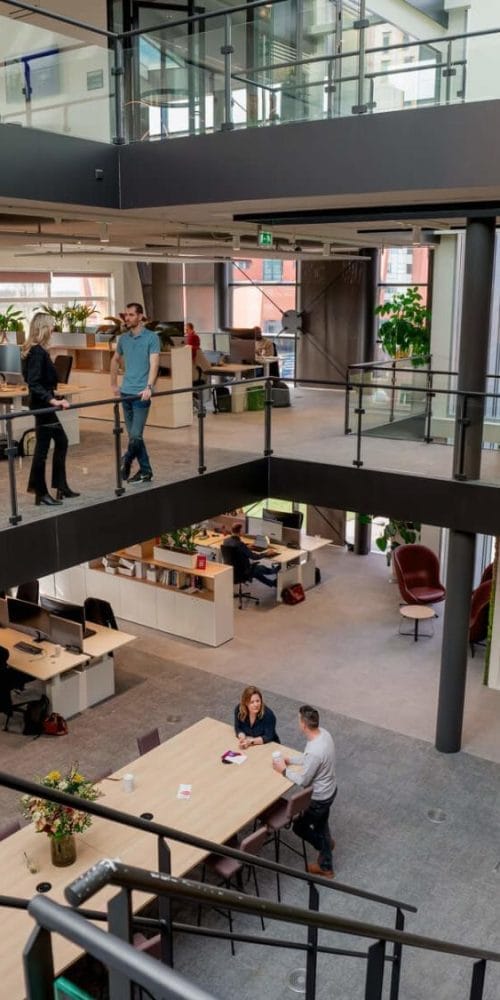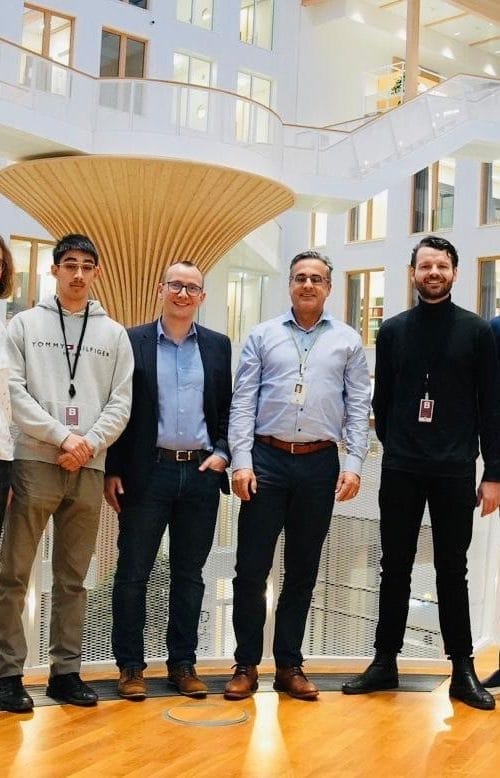Low-Code is a visual way of developing applications that makes it possible for a larger group of people to contribute to the development process, thus it is not just reserved for people with traditional programming skills. This allows people from different parts of an organization to collaborate in one environment, create solutions and iterate in a fraction of the time compared to traditional development methods.
Low-Code
The benefits of Low-Code
 Speed
Speed
Thanks to reusable building blocks, visual tools and drag-and-drop functionality, you can build a working application in no time.
- Deploy faster
Test an app, feature or idea and deploy with a few mouse clicks - Innovate faster
Capitalize on market developments with unprecedentedly fast time-to-market
 Flexible and scalable
Flexible and scalable
With Low-Code, you can just as easily create a new app, link to an existing API or add functionality to your existing systems
- Broad support
Out of the box support for APIs, workflows and AI models - Easily extendable
Quickly add new features with reusable components, reduced complexity and integrated development tools,
 Cost savings
Cost savings
Shorter development time means lower application build costs
- More efficient deployment
Doing more in the same time with existing staffing - Modern cloud apps
Dramatically reduce operational costs
 Bring business and IT together
Bring business and IT together
The Low-Code way of working brings developers and business professionals together so that software better supports business goals
- More insight and quicker adjustments
A visual workflow allows early and close involvement of business professionals - Fewer misunderstandings
Working together visually reduces the likelihood of miscommunication that leads to apps not working as expected
Low-Code vs. High-Code
Low-Code
- Visual interface with ready-made building blocks
- Quickly build applications for large group of developers possible
- Get early feedback thanks to rapidly testable prototypes
- Low-code is easy for novice developers to understand
High-Code
- Add functionality by writing lines of code
- Complexity creates long development time
- Feedback often not possible until first version, course changes are drastic
- Programming languages require a lot of time and experience
What analysts say about Low-Code
Low-code is the standard, Mendix is the leader
Organizations are increasingly using Low-Code to meet the growing demand for digital solutions and customized automation. The Mendix platform has been the undisputed leader in this sector for years, guaranteeing success.
Cloud native
Applications developed with Mendix are standard cloud-native, containerized and deployable anywhere. Whether in public, private, hybrid clouds or on-premises environments, Mendix provides the support that is.
Reusable building blocks
Use existing, reusable components to deliver solutions faster and easier.
Integrate data directly and securely
Leverage the capabilities of Mendix Connect and spend less time on complex and inconsistent integrations. Build reusable components and microservices faster than ever.
Native mobile
Develop, test and deploy mobile applications for all devices, browsers and operating systems on a single platform. Mendix provides the tools needed to turn ideas into results.
Unlimited possibilities
Mendix is an open platform and it offers unlimited possibilities to customize or extend both the platform and your applications to meet specific needs.
Manage and secure
Bring people, processes, portfolio together in 1 platform. The Mendix platform is the foundation you need to implement a Low-Code strategy for the entire development lifecycle of all your apps.
Benefits for each role

Big time savings with Low-Code
“We have managed to automate our contract management almost completely. This saves a lot of time and gives us more time to fully focus on growing Maximus.”
Tom Visschers
Managing partner at Maximus Real Estate Management

Live in 8 weeks
“I found this method to be special and it turned out to be a super beautiful baby.”
Maudie Derks
CEO Acture Group

Learned a lot
“We should have had this earlier! Not only do we now have a widely used application, but we also learned a lot from agile working, which we are now applying in our other projects.”
Rene van Goudzwaard
Head of Information Management at TBI

Meeting targets
“We have regained oversight of our projects and we can manage our projects more efficiently, which brings us significantly closer to our overall goal of making fiber available to everyone in the country.”
Martin Wanschers
COO at Glass Gate

Agile working method ensures fast delivery
“With Ciphix’s help, experience and expertise, we have implemented agile teams and a strategy equipped for the rapid delivery and execution of a minimum viable product.”
Edward Heijkers
CIO at AZL

Future-proof application landscape
“We are very happy with the new platform. Our application landscape is now future-proof and we can help our customers more efficiently and faster. We have also enjoyed working with Ciphix. They provide excellent support at both the strategic and executive levels.”
Gert Beliën
Director of ICT & services at Easytocare

Increase efficiency of organization
“By investing in back-office applications as an ICT department, we are creating the ideal preconditions to reduce client turnaround time and significantly increase the efficiency of our organization in the coming years. We partnered with Ciphix because they have the technology, expertise and experience to support this digitization process from start to finish.”
Klaas Nieuwhof
ICT director at GGZ InGeest

Away from paper and Excel
“Until recently, many of our complex business processes took place on paper or in Excel. To change this, we finally decided that a digital shell was needed over our entire IT landscape. After research, Low-Code turned out to be the perfect solution to achieve these goals.”
Jaap van der Welle
CIO at Mourik
Frequently asked questions:
How do you build the right application for a client?
Always start with clearly identifying the customer problem. It is common that applications are developed without first fully understanding what problem an application is supposed to solve. To avoid this pitfall, we begin always with a Design Thinking-session to develop a “shared understanding‘ to create. This approach provides a structured way to deeply analyze what the core problem is, for whom it provides what value, and how best to build or improve applications.
What can you do about an outdated interface in a portal or application?
At such a moment, dwell once again on what really important to the end user. Optimizing an obsolete interface by asking what the end user really wants shifts the focus to the user’s needs and expectations, which is essential for improving the end-user experience. In doing so, don’t just look at revamp of visual elements, but also to the optimize of obsolete processes. It is the ideal opportunity to customize not only the form, but also the function of the application to build an optimized interface that perfectly meets the needs of the end user.
How do I ensure that customers experience the same app/tech convenience as with a private app?
With customers wanting to experience the same convenience with business apps as with private apps, the first question is always what exactly customers mean by “convenience” and “usability. Since these are subjective concepts that are perceived differently by everyone, it is essential to first understand your customer’s specific needs and preferences as well as possible. By carefully asking about customers’ personal experience of ease of use, we can best anticipate a customer’s expectations and requirements and ultimately build applications where customers experience similar convenience to private apps.
What business processes can be automated?
There are several business processes at almost every company that can be can be automated. The most common processes that automatedrd are the invoicing process, inventory management and data entry. Software then then for example for that invoices are automatically prepared and sent and payments are tracked. As a result, fewer errors are made and employees spend less time on administration.
How does replacing legacy software benefit a company?
You can answer this question from different perspectives. If you look at cost and efficiency, you reduce costs, improve the user experience for customers and staff, and reduce your risks, particularly in the area of security. You can also look at this question from your company’s future perspective. A legacy migration provides you with a business that is digitally compliant. When good ideas come out of the business, you can estimate what it’s going to cost, what it’s going to deliver and how you can implement it. Ultimately, that’s something every business should be able to do.
This is how we help you
Also excited about the power of
Low-Code?
For more than 10 years, Ciphix has been an expert in creating high-impact Low-Code applications that really move your business forward.












